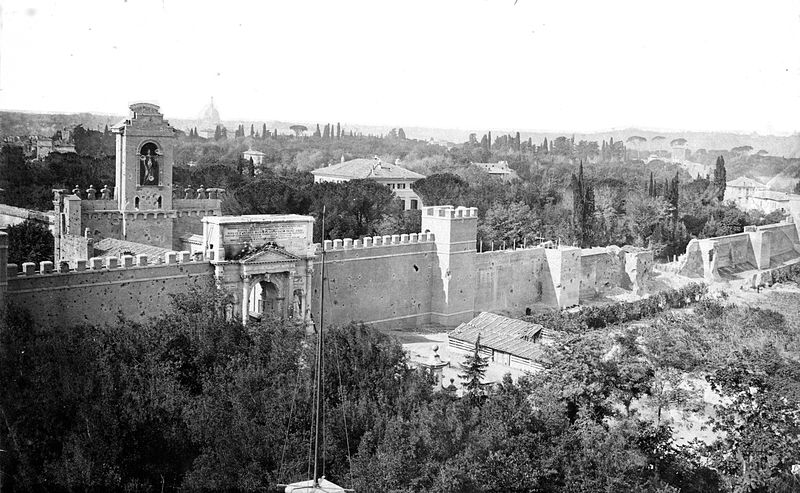La Breccia di Porta Pia Posted by Serena on Nov 30, 2011 in Uncategorized
Porta Pia is the name of the famous gateway designed by Michelangelo as an entrance through the Aurelian walls which once delimited the Stato Pontificio (Papal State). Ordered by Pope Pio IV as a replacement for the ancient Roman Porta Nomentana, Porta Pia was constructed between 1561 and 1565. Apparently Michelangelo presented three different designs to the Pope, all of which were beautiful but perhaps a bit too extravagant. In the end, however, the Pope chose the cheapest of the three. It was to be Michelangelo’s last architectural work, as he died shortly before it was completed.
If you ever happen to visit Porta Pia you might notice a strange decoration on the internal façade depicting a wash basin with soap and a hand towel. This is Michelangelo’s ironic artistic reference to the fact that Pope Pio IV was descended from a family of Milanesi Barbers!
La Breccia di Porta Pia (The Breach of Porta Pia)
150 years ago the long process of Italian unification was nearing its end. Only Rome resisted, presided over by Pope Pio IX, and supported by a garrison of French troops. The Pope remained obdurate: “Io non sono profeta, né figlio di profeta, ma in realtà vi dico che non entrerete in Roma” (I’m not a prophet, or the son of a prophet, but I sincerely say to you that you shall not enter Rome).
Famous last words! When the Italian Army approached the Aurelian Walls that defended the city, the papal force, commanded by General Karl Kanzler, consisted of a total of 13,157 men, against the 50,000 Italians led by Cadorna. On the 19 September 1870 the Italian army placed Rome under a state of siege, Pio IX having decided that the surrender of the city would be granted only after his troops had put up enough resistance to make it plain that the take-over was not freely accepted.
Finally, on 20 September 1870, after a cannonade of three hours had breached the Aurelian Walls at Porta Pia, the crack Piedmontese Bersaglieri troops entered Rome. One of the Barsagliere’s commanders, Edmondo de Amicis, describes the scene of the battle thus: “La Porta Pia era tutta sfracellata, la sola immagine della Madonna, che le sorge dietro, era rimasta intatta; le statue a destra e a sinistra non avevano più testa; il suolo intorno era sparso di mucchi di terra; di materassi fumanti, di berretti di Zuavi, d’armi, di travi, di sassi. Per la breccia vicina entravano rapidamente i nostri reggimenti” (“Porta Pia was completely crushed, only the image of the Madonna, which rose up behind, remained intact; the statues to the right and left were headless; the soil all around was covered with heaps of earth; smoking mattresses; Zuave’s* berets, weapons, beams, rocks. Through the nearby breach our regiments rapidly poured in”).
*The Zuavi Pontifici were mainly young, unmarried, Roman Catholic men, who volunteered to assist Pope Pius IX in his struggle against the Italian Risorgimento.
A contemporary photo showing the breach in the wall to the right of Porta Pia
56 years later, on the 11th of September 1926 another famous event took place near Porta Pia when the Italian anarchist Gino Lucetti (August 31, 1900 – September 15, 1943) attempted to assassinate Benito Mussolini by throwing a bomb against the dictator’s car. The bomb failed to detonate and Lucetti was arrested and sentenced to 30 years in prison. He was held in Santo Stefano for nearly 17 years before being transferred to Ischia where he died in an air raid on 15 September 1943.

Build vocabulary, practice pronunciation, and more with Transparent Language Online. Available anytime, anywhere, on any device.





Comments:
Philip:
Serena,
Grazie. Me piace la sua “blog.” Io non scrivo o parlo bene l’italiano. Ho studiato per 6 mese.
Per favore, in la futura, puo’ spiegare la differenza tra capire e comprendere; e la differenza tra conoscere e sapere?
Grazie.
Phil
Serena:
@Philip Salve Philip e benvenuto nel blog.
Complimenti, se studi l’italiano solo da sei mesi sei molto bravo!
‘Capire’ e ‘comprendere’ sono praticamente sinonimi, ma in italiano ‘capire’ è molto più usato.
Per quanto riguarda la differenza fra ‘sapere’ e ‘conoscere’ ho già scritto un articolo molto tempo fa. Ecco il link: https://blogs.transparent.com/italian/homo-sapiens/
Saluti da Serena
Philip:
Salve, Sarena.
Io leggaro` l’articolo.
Grazie e Buon Natale!
Phil